| Pages:
1
2
3 |
antekboodzik
Oud Junkie
    
Posts: 109
Registered: 5-24-2010
Location: north poland
Member Is Offline
|
|
Fighting with lute bowl - round two.
Hi,
Instead of all, I didn't give up with an idea to make renaissance lute at my own. Having been collecting pieces of information over the net and
following your advices now I have another, not perfect but yet along better bowl, now in maple. Ribs are quite thin, about 1.35 mm, neckblock is made
out of basswood. I managed to have the "balloning" effect not to be more than 1 - 2 mm, and the final shape differs from the designed one only a very
little. But I still got some troubles when fitting the ribs together - some of the joints are tight and even hardly noticeable, but some of them have
a gap... And I won't show you what's happen under the endclasp  How to avoid it
in future? Is it really so hard job (or best kept secret of instrument making How to avoid it
in future? Is it really so hard job (or best kept secret of instrument making  )?
)?
Anyway, I am going to finish this my very first instrument. I got mahogany block big enough for neck and some scraps of beech for a pegbox. Please,
help me to design them. Especially - how wide the neck should be at body joint and an the nut, I think, for a six course instrument, to have it
comfortable to play?
Best regards, Antek.
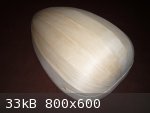
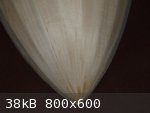
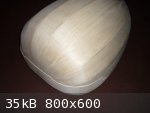
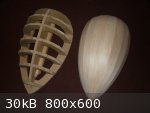
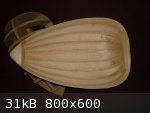
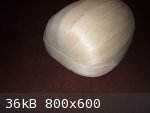
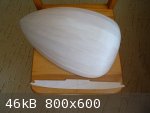
|
|
|
jdowning
Oud Junkie
    
Posts: 3485
Registered: 8-2-2006
Location: Ontario, Canada
Member Is Offline
Mood: No Mood
|
|
Pretty good for a first attempt. There are no secrets - achieving perfect rib joints is learned through making rib joints - like most manual skills it
cannot be taught but is inherent in the natural abilities of the craftsman. Your next lute (or oud) bowl will be more perfect than the last and less
of a fight now that you have made one.
The most difficult areas for making perfectly fitted joints is at the ends of the ribs - particularly at the bottom end of the bowl where the compound
curvatures are greatest. The end clasp or cap is there not only to reinforce the bowl in the 'below bridge' area but to cover up any gaps in the
joints and nail holes used to temporarily secure the ends of the ribs to the mold. Any gaps at the neck block end will likely be removed when the neck
joint is cut. However small joint gaps will not affect the integrity of the bowl due to the joint reinforcement strips inside the bowl. Slight gaps
are more visible on bowls made of light coloured woods but much less so if dark coloured woods or alternating dark and light woods or dark liner
strips set between the ribs are used (one secret I suppose!)
I note that you have used an oud like tail block inside the bowl. This will likely not affect anything but lute bowls of the renaissance period had
not only an exterior end clasp but also a thin, hot bent, softwood counter clasp glued inside the bowl. This is glued in place after the bowl has been
removed from the mold.
Also it is best to cut the neck joint before assembling the ribs and bowl to ensure accuracy.
How did you determine the geometry of the bowl - is it based upon an historical instrument (Maler or Frei perhaps from the appearance of the bowl)?
What are the completed dimensions?
It sounds as though you have not made a full sized drawing of the lute in order to determine critical details like string length, string spacing at
nut and bridge, bridge position, sound board bracing, sound hole diameter and position, neck length etc.? If not then this might be a good time to do
so - using a tracing of the bowl profile as a starting point.
Once the relative positions of the above have been established then the neck joint width can be accurately determined.
A six course instrument is fine for the extensive surviving early Renaissance lute repertoire but seven or more would be more appropriate for the late
Renaissance period. Note that the extra courses on a lute, beyond the six stopped courses on the fingerboard, are generally played open and not
stopped - an additional complication but not so difficult as might first appear.
|
|
|
antekboodzik
Oud Junkie
    
Posts: 109
Registered: 5-24-2010
Location: north poland
Member Is Offline
|
|
Thanks a lot for your support 
Yes, indeed, I am very fascinated in modest, but very elegant and "natural" lines of Maler's and Frei's renaissance lutes. I made some plan for
figuring some of my ideas. It is in the attachment. All dimensions there are in full-size, so if you open it with GIMP software (or print) and switch
measures to mili-metres you coud see real dimensions. But there are:
- 600 mm for string lenght (at least in the center line of instrument),
- 290 mm max width of the belly (approx.), the finished bowl is wider a little (1-2 mm),
- 50 mm width at the nut,
- 60 mm width at the neck-body joint,
- slightly less that 80 mm between first and last string at the bridge (it was very hard for me to be precise here, as I am not sure about strings and
courses spacings).
I am not sure if these dimensions make sense - I was trying to imagine how it could be, but from that time I was drawing it, I played a little on a
pretty strange XIX c. guitar, it just had nearly same width of nut and I found it not so comfortable. Also, for a now, I think the taper of the neck
(looking from the front) should be more pronounced. What do You think about it? ANyway, I think this is a very good idea to rewrite the plan and
revise it all.
Some more issues:
- I choose the way to make bowl with both blocks screwed to the mould just because, I have no idea what to do to have the ribs not to be glued up to
the mould  Of course, I could put some thin plastic under ribs, but it hadn't
been my favorite thing to do. Of course, I could put some thin plastic under ribs, but it hadn't
been my favorite thing to do.
- I was preparing the ribs only with very basic shape, wider and longer, and then, after bending, fitting the joining side by plane, and for final
touch I used sandpaper glued to flat surface. When it was at least fairly acceptable, I was determining the outline of another side comparing it to
bulk edges of my mould, and preparing it same way - is it a proper approach?
- With top ribs I did it another way - I realised what you said, that the "balooning" effect occurs where the curvature is the biggest. So I fitted
paper strips, and then marked slightly another shape of these two top ribs. It is on the picture (the second one). Fail or not?
Next time I will carefully consider your advices. ALso, I was thinking about spacers, but again, for me it somehow does not match with plain, 9-ribbed
body. For a bowl with greater number of ribs of course, but not now.
Edit: I forgot, I haven't seen any drawed plans, and saw only two lutes (both after baroque instruments) in my life  That plan is just my imagination about how it can be. That plan is just my imagination about how it can be.
Attachment: plan.xcf (396kB)
This file has been downloaded 258 times
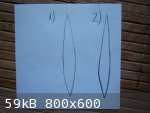
|
|
|
jdowning
Oud Junkie
    
Posts: 3485
Registered: 8-2-2006
Location: Ontario, Canada
Member Is Offline
Mood: No Mood
|
|
If you go to the Guild of American Luthiers website and check out the images of the lute plans - plan #17 by the late Robert Lundberg is of a "6
course Renaissance Lute, H. Frei ca. 1530". String length is 62 cm and there are 11 ribs in the bowl otherwise your drawing - profile, bracing, neck
length etc appears to be pretty well identical when compared to the same scale. The Lundberg drawing is not an exact copy of a surviving instrument
but should be a good working model to follow.
None of the Maler or Frei lutes survive in their original state having been modified at a later date to 'Baroque' style lutes so trying to determine
how they were braced for example requires a bit of detective work and speculation. You can read about the Maler model on this forum. Check out page 2
of "Old Oud compared to Old Lute Geometry" and "A Rebuild Project - 14th C Oud to 16th C Lute" for details.
String spacing overall at the bridge on my reconstruction of a Maler lute (five double courses, with single treble - string length 67.5 cm) is 75 mm
and at the nut 38 mm. Nut width is 45 mm. Neck joint width is 62 mm (so 60 mm should be good in your case). String spacing depends upon personal
preference. In my case the distance between courses is about 5 mm at the nut and 10mm at the bridge with the strings of each course being separated by
2 to 3 mm at the nut and 4 to 5 mm at the bridge.
For information on the method I use to construct a bowl see pages 7/8 of "Old Oud - New Project" on this forum. To prevent the ribs sticking to the
mold I place strips of 'oven proof' (heat resistant, non stick) paper under the rib joints as they are assembled. The paper is removed as each joint
is completed and to be sure that nothing is stuck to the mold surface, I run a thin metal spatula under each joint as it is completed. Don't use
plastic under the joint if using the hot hide glue method as it may melt and stick to both rib and mold surfaces!
The outside ribs are usually made a bit wider than the rest.
For a bowl that is perfectly semicircular in profile finishing the rib joints with sandpaper glued to a flat surface works pretty well. Note however
that many historical lutes (Frei and Maler included as well as some old ouds) do not have perfectly semi circular sections but are deeper at the neck
block end. Also some of the larger lutes of a later period had significantly flattened bowl sections. For these, the ribs (often over 30 in number) -
after rough shaping - must be individually fitted with plane and file to obtain perfect joints. Rib spacers can be of some benefit here in disguising
any slight joint imperfections.
Rib widths should be checked for reasonable consistency as work proceeds on fitting and assembly of the bowl to make sure that the finished bowl looks
symmetrical.
Edited: My Maler lute reconstruction is a six course instrument with five double courses and single treble.
|
|
|
antekboodzik
Oud Junkie
    
Posts: 109
Registered: 5-24-2010
Location: north poland
Member Is Offline
|
|
Thank you again for your reply, jdowning. I appreciate your sincere answer.
Well, I saw that website, and realized that some lines, indicating suond bars I suppose, are placed in some way of simple proportion by dividing
particular distance by two or three... and my bowl is a little more bulgy, but follows some body to neck proportions. But anyway, with your answer now
I feel more confident and I would stick to my dimensions. I don't make my mind abour course count yet, I'll decide soon.
But anyway, another thing exercise me strongly - "standard" guitar's necks are a lot wider... 50-55 mm at nut or so. Why? Is it much different for the
lute?
Edit: Ouch, and again I forgot something. With my top ribs I meant, that all but top ribs are quite symmetrical, and top ribs not. They have
significantly different sides to match other ribs, and thus, in some areas the angle between top ribs and precedent ribs is slightly different (less
angled).
|
|
|
jdowning
Oud Junkie
    
Posts: 3485
Registered: 8-2-2006
Location: Ontario, Canada
Member Is Offline
Mood: No Mood
|
|
GAL plan #17 does not specify which historical instrument the plan is based upon so it is not possible to determine how much of the bracing geometry
is original. My guess - judging from the small image of plan #17 - is that Robert Lundberg based his design on one of the Frei lutes in the
Kunstshistorisches Museum in Vienna (not # C34) as some of the bracing at least is visible through cracks in the sound board and proportionally they
seem to fit the drawing layout (more or less). The same applies to the bridge and sound hole position.
This being the case two bars running across the soundhole replace one central brace in the original, a brace has been added between the sound hole and
neck block as well as a partial brace below the bridge - all reasonable additions.
Hard to say if this bracing layout represents the original early 16th C configuration or that of a later date when the instrument was modified to an
11 course lute - probably the latter.
The early lute makers did work to proportions in designing their instrument geometry and bracing layout.
Modern classical guitar string spacing at the nut is generally a bit wider (41 mm?) than lute or early guitar spacing so the nut is made
proportionally wider. The choice of string spacing all depends upon hand size I suppose.
|
|
|
jdowning
Oud Junkie
    
Posts: 3485
Registered: 8-2-2006
Location: Ontario, Canada
Member Is Offline
Mood: No Mood
|
|
A bit more information on the Frei lutes after checking my files. I know of four surviving examples of lutes that are labelled 'Hans Frei' although
the example in Bologna Museo Civico #1755 may not be by Frei (?) - it has a bowl of 9 ribs. The other three lutes have all been converted to 11 course
lutes and all have bowls with 11 ribs. That is not to say, of course, that Frei never built bowls with 9 ribs.
According to English luthier Martin Shepherd, the sound board of the Frei example in the Warwick County Museum shows traces of a below bridge brace
placed across the full width at that location (not a partial brace as indicated in the GAL plan) as commonly found in oud bracing. I was not aware of
this when I wrote FoMRHI Comm. 1237 "Below Bridge Bars - a Missing Link" in January 1994 (see my topic of December 2007 on this forum with the same
title for a copy of the Comm.) so this 'new' information supports the substance of Comm. 1237 quite nicely.
|
|
|
jdowning
Oud Junkie
    
Posts: 3485
Registered: 8-2-2006
Location: Ontario, Canada
Member Is Offline
Mood: No Mood
|
|
Note my post of June 2nd has been edited to avoid any confusion.
My reconstruction of a Maler lute mentioned is a six course instrument with five double courses and a single treble course. Note that the string
spacings allow for all gut (or silk) stringing as well as modern nylon strings.
|
|
|
antekboodzik
Oud Junkie
    
Posts: 109
Registered: 5-24-2010
Location: north poland
Member Is Offline
|
|
Dear Mr. JDownig,
Thank you a lot for your attention. It took me some time to carefully read all your posts you mentioned. But in all, it is marvellous, and I
appreciate a lot your contribution to this forum and all newbies in lutemaking 
By the time, I made careful drawing and decided about all measurements. Also, I did some progress. Here are: mahogany neck and freshly prepared
pegbox. "Walls" of the pegbox are made out of ash (or beech, I am not 100% sure), the wood for it was taken from... very old broomstick  Two blocks are from basswood, also thin maple veener will close the back of it. Two blocks are from basswood, also thin maple veener will close the back of it.
I am going to stain neck and pegbox black - with ordinary black ink from papery-store, and cover it with shellac, to not to have the neck leaving
black blushes on the hands. I realize it is maybe not the best option, and not historically appriopriate - but how can I do it more professionally?
Best regards,
antekboodzik.
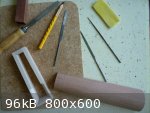
|
|
|
jdowning
Oud Junkie
    
Posts: 3485
Registered: 8-2-2006
Location: Ontario, Canada
Member Is Offline
Mood: No Mood
|
|
Progressing well - good for you antekboodzik.
It is often difficult to stain hardwoods a dense uniform black using wood stains as they tend to show the wood grain and would likely not disguise the
different woods that you are using for the neck and pegbox (if that is your objective).
So - best to avoid staining woods if you can. Keep it simple - let the natural beauty of the wood shine through!
However, to stain the neck a dense black I would use not an ordinary black ink but so called 'India Ink' - once used by draughtsmen - still available
from office supply or art supply stores. This ink contains shellac and is water resistant. So you could use this without a protective coat but it
would soon wear through to the unstained wood of the neck.
I also use this ink to stain lute pegs.
To protect the stain on the neck from wear you should use a hard varnish such as modern polyurethane clear varnish - used to protect wooden floors.
Shellac is not durable enough for the neck (but is fine for the pegbox) and would soon wear through both the shellac and ink stain to the unstained
wood underneath.
The maple neck of a lute that I use daily has been treated in this way - India Ink and a hard Polyurethane varnish - and after several years use is
just starting to show signs of wear close to the pegbox.
The early Maler and Frei lutes do not survive in their original condition but it is quite likely that the necks may have been left unstained or even
unvarnished.
This is the simplest and best solution as far as future maintenance is concerned and one that I would recommend in your case - unless you really want
a black coloured neck that will inevitably show signs of wear later.
The lutes of a later period often had the back of the necks veneered with a dark hardwood like Ebony (to keep the weight down on these larger
instruments, the neck core would have been a soft, lighter wood such as basswood or lime-wood) - but most of the surviving lutes were high quality
presentation instruments (that is one reason that they have survived) rather than the lower cost variety of their day that didn't. The latter may well
have had plain hardwood stained necks to keep costs down but we will never know.
Keep up the good work.

|
|
|
antekboodzik
Oud Junkie
    
Posts: 109
Registered: 5-24-2010
Location: north poland
Member Is Offline
|
|
Nice, thanks a lot! I have checked, here so-called Indian Ink and China ink are easy available. I will give a try.
And yes, my plan to stain the neck is to have same colour to the neck and pegbox. And also, my attempts to build an instrument is just a kind of
experimenting, as well I can not afford professional instrument for a now (by the way, what do you think about EMS and so called paki lutes?). I
understand some postulates about being historically correct, bu t at least if I were finished with playable instrument, I would be very happy. How did
you start making instruments, if I can know?
Final finish of surface of my instrument (if I will go so far) is another question. I am able to do french polish, but I think better, and
historically correct, would be to put some varnish. I did some trials, but it is still a problem to me to be solved. Another one is Pegs for my
instrument.
And also, I have purchased spruce wedge, it was prepared to make a viola top, but is wide enough to provide a soundboard for my lute 
|
|
|
jdowning
Oud Junkie
    
Posts: 3485
Registered: 8-2-2006
Location: Ontario, Canada
Member Is Offline
Mood: No Mood
|
|
A brush applied oil varnish is good and authentic - however, use the 'quick' drying stuff formulated for violin makers - unless you want to spend
several months finishing your lute. Brush varnishing requires a bit of practice for best results but otherwise is not too difficult - unless using
colored varnish which is. Stick to clear oil varnish if you decide to use an oil varnish and use a soft good quality brush designed for oil
varnishing.
Note that the surviving Maler lute bowls were finished with a deep red varnish. Not sure about the Frei lutes.
I have been making plucked stringed instruments since 1963 - early guitars, lutes, vihuelas etc. + Irish harp and oud - all for my own use and
research purposes - so have never had to purchase instruments or components made by others (except for the strings - and I am currently working on
that). So I have no experience of dealing with EMS (Early Music Shop?) or with lutes made in Pakistan.
You should be able to purchase ready made lute pegs on line but I cannot make any recommendations because I have always made my own pegs.
|
|
|
fernandraynaud
Oud Junkie
    
Posts: 1865
Registered: 7-25-2009
Location: San Francisco, California
Member Is Offline
Mood: m'Oudy
|
|
For what it's worth, Panie Antku, Dov Schmidt in the US sells a lot of pegs, including the more plain viola and oud pegs, for $1-$2 each. The viola
pegs are sold in kits of 4, the oud ones in kits of 12. You might find something on his site. They're light and don't cost much to ship. It seems hard
enough to fit good pre-made pegs, let alone making them!
http://www.dov-music.com/catalog.asp
|
|
|
jdowning
Oud Junkie
    
Posts: 3485
Registered: 8-2-2006
Location: Ontario, Canada
Member Is Offline
Mood: No Mood
|
|
Those pegs seem to be a good deal and with a shank length of 61 mm should be long enough for a 6 course early 16th C lute. However the head width on
oud pegs generally are quite a bit wider than found on lutes. So for the relatively short pegbox length of an early 16th C lute you will need to check
that there is sufficient space between the pegs to allow rotation of the pegs. The peg heads on my lutes for example measure anywhere between about 14
mm to 18 mm across (depending upon the style of lute) with a minimum gap between the peg heads of about 10mm to allow comfortable turning of the pegs
with the fingers.
Of course, if a peg head is too wide, they can always be cut down and reshaped to fit.
|
|
|
antekboodzik
Oud Junkie
    
Posts: 109
Registered: 5-24-2010
Location: north poland
Member Is Offline
|
|
Dears,
thank You very much for yours help. I like the walnut pegs a lot, I have e-mailed them and I will go into it.
Panie Fernandzie, bardzo chętnie bym się z Panem skontaktował na privie 
|
|
|
antekboodzik
Oud Junkie
    
Posts: 109
Registered: 5-24-2010
Location: north poland
Member Is Offline
|
|
Hi, here's some progress I did recently. This is my setup for thicknessing halves of the top. I found a wood-carpenter, who did a resaw for me, but
unfortunately, with his very big bandsaw he was able to make 8-9 mm thick plates from a wedge only. I found, that thicknessing it by my small block
plane is possible, but a very hard job, even if the plane is really sharp. What I could do to make it easier and faster? Maybe this is the time to
join halves and rougly cut the layout of the top - there would be less wood, or I can use some gouges to remove some portions of waste wood?
By the time I prepared very basic calipers - even somehow fragile, it works, but anyway, I will make another one using aluminium bars/profiles.
[file]24209[/file]
Also, another consideration is the final thickness of my top. Any Your suggetions are welcome 
Best regards, Antek.
|
|
|
antekboodzik
Oud Junkie
    
Posts: 109
Registered: 5-24-2010
Location: north poland
Member Is Offline
|
|
Lute belly planed to thickness and the rose in progress.
I have decided to go with a little thicker top, following some suggestion I found over the net, and also some advice that the guy, who sells me
material for a top (actually a luthier) gave me. It vary from 2,6 mm under the bridge to 1,7 mm at the edges, and has something like a center-lined
tchickness more than areas nearer to the sides. That's just my idea of it, we will see if it would work or not.
And this is my very first time I work with a belly and a rose. I choose a somehow simplified version of a rose, that I found for free over the net,
just for better chance to succes. I must admit, as an unexpreienced one, I made some faults. At first, I was too shy when sanding the circle for a
rose - it was done to about 1,4 mm, and now I think I should spent more time with it, graduating it to 1 mm or so. Then, I cutted the edges of "voids"
exactly with the lines, which now I find it not the best idea. Cutting a very little off the lines (smaller voids) gives you better control over
entire process. However, I came over it, better or less, and I am very happy of it (only two times I need to use glue to put back some small pieces I
have chipped off - as far as I know the ordinary paper glue is made from natural, plant-origin ingredients). Next step would be to carve the rosette
to have a "3-dimentional" outfit 
Please, keep fingers crossed for my work. I am in big distress that if my instrument will hold the strings tension, and not collapse or so. That's my
only, hereby wish...
[file]24333[/file] [file]24335[/file] [file]24337[/file] [file]24339[/file] [file]24341[/file] [file]24343[/file]
|
|
|
fernandraynaud
Oud Junkie
    
Posts: 1865
Registered: 7-25-2009
Location: San Francisco, California
Member Is Offline
Mood: m'Oudy
|
|
I'm not sure, but I think "paper glue" could be many different things, from starch and water to fish glue to different kinds of plant or synthetic
resins.
|
|
|
jdowning
Oud Junkie
    
Posts: 3485
Registered: 8-2-2006
Location: Ontario, Canada
Member Is Offline
Mood: No Mood
|
|
Your lute sound board thickness as you report will not result in collapse under string tension if the sound board is properly braced.
The area of the rosette should be thinned to about 1 mm to make piercing the pattern easier. It also helps to harden and strengthen the outside area
of the rosette with a coat of shellac prior to cutting. I cut lute rosettes through this thickness with direct 'stabbing' cuts (using fine thin
chisels made from old hacksaw blades) on the lines from the pattern side with a hardboard backing as support. It is not unusual for small pieces to
break off in the process (although with care this can be avoided) and it is OK to glue these back in place with whatever glue is convenient to work
with - as the rosette is not a structural component of the sound board. In any case the underside of the the rosette will eventually be supported with
multiple thin bars glued across the underside of the rosette.
The carving of the outside face of the rosette can be done with a sharp scalpel blade or fine craft knife. I first mark the incised lines in pencil
(to avoid mistakes) and then cut a V groove on either side with the knife held at a 45° angle - cutting almost full depth. The original rosettes were
cut very boldly with double parallel incised lines. If you are not confident enough to cut two parallel incised cuts like the originals then just
stick with a single incised cut that will be satisfactory and make all the difference to the appearance of the rosette. The original Maler design that
you are following also has an interwoven foliage motif that should be lightly carved to remove some of the sharp edges - but err on the side of
caution as these are easily broken.
I seem to recall having posted some detailed information on how to cut lute rosettes on this forum some time ago. See 'Old Oud - New Project' topic
pages 6 and 7.
The image is a Maler style rosette on one of my lutes. Note that there is very little carving of the 'foliage' component- I did not want to risk
breaking it - but it would look better carved to almost nothing like the originals
[file]24347[/file]
|
|
|
antekboodzik
Oud Junkie
    
Posts: 109
Registered: 5-24-2010
Location: north poland
Member Is Offline
|
|
Hi, thanks for Your replies 
Here is the result. It's clumsy a little bit, but at my first try I am quite happy with it:
[file]24349[/file]
|
|
|
dkhoury35
Oud Junkie
    
Posts: 181
Registered: 11-3-2010
Location: Melbourne Australia
Member Is Offline
Mood: IM IN THE M-OUD
|
|
looks great not clumsy
|
|
|
jdowning
Oud Junkie
    
Posts: 3485
Registered: 8-2-2006
Location: Ontario, Canada
Member Is Offline
Mood: No Mood
|
|
Nicely done antekboodzik.
Requires a sharp knife, a steady hand, good eyesight and lots of patience.
|
|
|
antekboodzik
Oud Junkie
    
Posts: 109
Registered: 5-24-2010
Location: north poland
Member Is Offline
|
|
Hi, just two things more are unclear to me. Please, help me 
Shall the ends of braces touch top ribs from inside of the bowl? Also, what with the inner linings, like on the guitar? I have never seen inner
linings over the net, and thus I think gluing braces to the bowl would even stabilise the bowl and enforce belly/bowl joint. But also I have observed
few guitars, where due to shrinkage braces punched trought sides, and even "pops" tables. Then also, with braces touching top ribs, the eventual later
top removal would be more complicated.
If brace's ends should be left free, would only a small egde of top ribs hold the top securely? Please, tell me how it should work.
Best regards, Antek.
|
|
|
jdowning
Oud Junkie
    
Posts: 3485
Registered: 8-2-2006
Location: Ontario, Canada
Member Is Offline
Mood: No Mood
|
|
Lutes are not fitted with interior liners around the top edge of the bowl but some of the later period lutes with 10 to 14 courses sometimes had
additional strips added to the outside of the top ribs. This may have been for additional stiffness under higher string tension loadings or a later
addition to repair top ribs damaged due to repeated sound board removal for repairs.
The ends of the braces must be a precise fit to the sides of the top ribs and the ends glued securely to the ribs - all necessary and important for
structural support of the sound board.
Removal of a sound board is not a problem as long as hot hide glue is used to glue the edges of the sound board and ends of the braces to the ribs.
The gluing surface of sound board to top ribs is usually about 1.5 mm wide (i.e. rib thickness) except at the bottom edge of the bowl where it is
reinforced with an exterior end clasp and matching interior reinforcing end plate - more to provide added stiffness to the sound board area below the
bridge.
|
|
|
antekboodzik
Oud Junkie
    
Posts: 109
Registered: 5-24-2010
Location: north poland
Member Is Offline
|
|
Hi,
there are my "lazy" go-bar press, and all of braces in place and scalloped, but not trimmed to correct lenght yet.
How do You like it?
[file]24399[/file] [file]24401[/file] [file]24403[/file] [file]24405[/file]
|
|
|
| Pages:
1
2
3 |